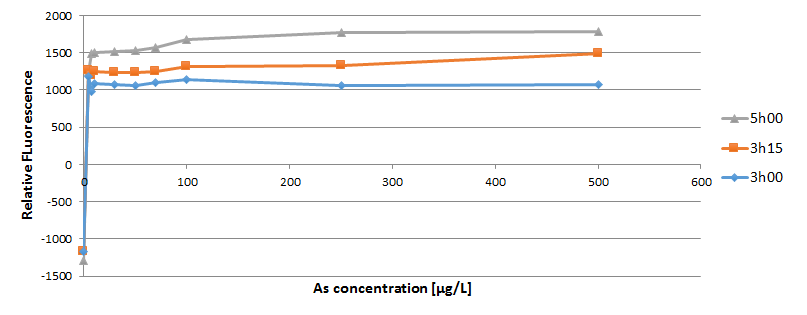- français
- English
Second experiment
The goal of this experiment was as new to compare LSS mOrange and eGFP fluorescence.
To perform it we used different strains of bacteria DH5α :
- with no bioreporter
- with LSS mOrange (the bacteria come from the stock and are conserved at -80° in glycerol)
- with LSS mOrange (the bacteria come from the plate and are conserved at 4°)
- with eGFP
- with AsrR, the protein expressed in presence of arsenic by E.coli
After verification with the spectrometer (OD600), we note that only bacteria with LSS mOrange from the stock and with eGFP grow.
Here are the results we got :
|
Bioreporters |
2h of growing |
3h of growing |
|
no |
0.01 |
0.02 |
|
LSS mOrange (stock) |
0.18 |
0.48 |
|
LSS mOrange (plate) |
0.05 |
0.00 |
|
eGFP |
0.21 |
0.52 |
|
AsrR |
0.03 |
0.11 |
Table : Absorbance OD600 of the five cultures of bacteria
We note that for LSS mOrange bacteria from the plate, they might not be potent anymore.
After performing the measurement with the fluorimeter, we have no fluorescent emission by the solution with eGFP. It is possible that we had a problem when mixing eGFP bacteria with the MOPS. In fact, the comparison with LSS mOrange is impossible.
Here is the result we got for LSS mOrange bacteria :

Figure 3: Relative fluorescence of LSS mOrange in function of different Arsenic concentration after 3h, 3h15, 5h and 7h30 of incubation.
We got the expected curve shape : the relative fluorescence increases rapidly between 0 and 100µg/L of arsenic concentration and then reaches a plateau. It increases a few with the incubation time.
The negative values at [As]=0µg/L indicate a very low absorbance.
So we can conclude from this result that LSS mOrange needs a time of maturation, maybe longer than 5h.
- Ce wiki
- Cette page
